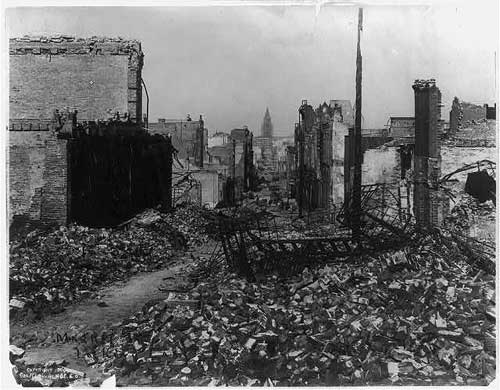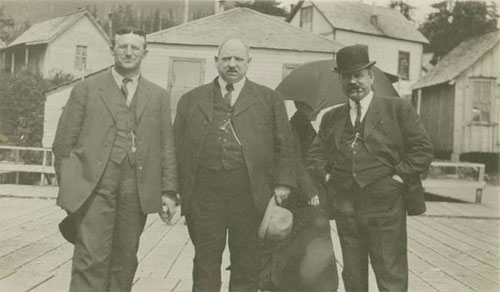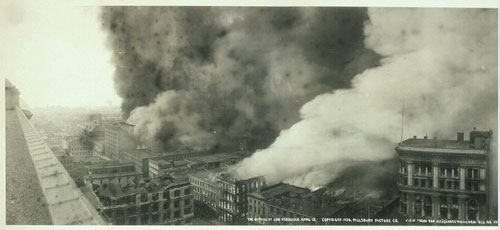 J.R. Heckman, Captain Sayles and the San Francisco Earthquake By DAVE KIFFER April 18, 2006
The ripples from the 8.3 magnitude quake would be felt more than 1200 miles away in the small, growing village of Ketchikan.  Ruins after the San Francisco earthquake. Photograph Courtesy Library of Congress Prints and Photographs Division Washington, D.C.
Bushell's manuscript "Mary and I in the Alaska Panhandle" is in the archives of the Tongass Historical Museum. It was written sometime between 1916 and 1920, after Bushell and his wife returned to Washington state after running the Ketchikan Miner newspaper in the middle part of the 1910s. The story of J.R. Heckman, Captain Jimmie Sayles and the great San Francisco earthquake takes up almost the entire third chapter. James Robert Heckman, who died in 1939 at the age of 73, was one of the pioneer founders of Ketchikan and was one of the most prominent members of the salmon canning community that came to dominate Ketchikan in the late 1910s and early 1920s. According to his obituary in the August 21, 1939 Ketchikan Chronicle, the Nova Scotia native came to Alaska in 1886 "against the advice of his parents." "Few men know him as Jim or even as Mr. Heckman," the Chronicle wrote. "They know him rather as Bob or J.R. He has been characteristically friendly, characteristically aggressive, characteristically successful. Even today after nearly 55 years in Alaska, Senator Heckman still was prominently identified with northern progress."  Donor: Mrs. Al Hagmoe, Photograph courtesy Tongass Historical Society
In 1906, the Alaska Packers Association was based in San Francisco and it was not unusual for Heckman spend several months each winter at the company offices. Bushell and his wife Mary had arrived in Ketchikan in the summer of 1905 and Bushell had taken a job printing the Ketchikan Mining Journal. He wrote about his experiences in his manuscript which was later sent by his family to Ketchikan. The first big event that happened during Bushell's time in Alaska was the San Fransisco earthquake and the stories of the local folks who were involved. "Late every winter Bob would go down to 'Frisco' to arrange policy and operating plans with the packing company heads for the coming season and in 1906 he and Mrs. Heckman went south expecting to finish there and be on their way north on or about the first of May," Bushell wrote. But fate intervened on April 18. Naturally, it took a couple of days for word of the San Francisco catastrophe to reach Ketchikan. On the morning of April 20, Bushell was out rounding up news and advertising copy for the daily paper. He was down by the docks when he someone call out that a steamboat was arriving. Bushell noted he was surprised because one wasn't do in town that day. He recognized the boat as the freighter Dirigo. The boat tied up and he began talking to one of the passengers, a traveling grocery salesman, Oak Olson about the schedule for the steamer Jefferson which was due in town in a couple of days. Olson had been in Juneau the day before and had heard the San Francisco news. "Then he hit us with a bombshell 'Had we any late news on the San Francisco disaster,'" Bushell wrote. "There was neither cable nor wireless into Ketchikan at that time, so we didn't know what he was talking about, so I asked him to explain. He did with the information that San Francisco had been wiped out by a devastating earthquake and subsequent fires April 18, that is a couple of days before." Word quickly spread and soon more than 50 people were gathered at the dock. "Soon, it seemed to me that every man in Ketchikan was there." Bushell wrote. "They all knew that Bob Heckman and his wife, together with Capt. Jimmie Sayles and other Southeastern Alaskan cannery and steamship people, had last been heard from at San Francisco, which was then the chief canning supply point on the coast. So we all wondered -- had they left San Francisco before the quake or been caught in the great catastrophe?"
Photograph courtesy Library of Congress Prints and Photographs Division Washington, D.C. Bushell went back to the newspaper office to put the day's newspaper together, but an hour or so later, the crowd of concerned residents tracked him down at the office. "They wanted action -- had chartered the 40-foot seiner Eurus, were gassing her up, had raised $100 for telegraph tolls and expenses and wanted me to go down a hundred miles or so across the international line to Port Simpson.contact someone in Oaklandand thus get some first hand information on Bob Heckman and the others," Bushell wrote. "Would I go? I certainly would! It was my first trip in a small vessel in the choppy waters of Alaska. We bucked strong headwinds down Tongass Narrows and Revillagigedo Channel and the seas piled up as we came abreast of Mary Island and at last entered Dixon Entrance with nothing on our starboard side between us and Japan, but rough water, and more rough water." Bushell wrote that he was very seasick during the eight hour boat to Port Simpson, now called Lax kw'alaams, a village 35 miles north of Prince Rupert near the Alaska-Canada border. Unfortunately, he arrived well after midnight and there was no one at the Dominion Telegraph office. They went to roust the operator out of bed and then contended with a very angry woman, who turned out to be the operator's mother. Bushell wrote that it took a lot of explaining to finally convince the woman about the importance of their mission. She finally woke her daughter up. They contacted operators farther south and started the learn the facts about the disaster which were still pretty bad. "The lower part of San Francisco had been smashed by the worst earthquake ever experienced on the North American continent," Bushell wrote. "This had been followed by several fires, the worst of which was still burning out of control, and with no water to fight it owing to the broken water watermains and the streets so full fo wreckage from the shattered buildings that traffic was virtually at an end." The good news was that Bushell was able to determine that the Heckmans and Captain Sayles were reported alive and well by the San Francisco police and would be heading north very soon. With than information in hand, Bushell set sail back for Ketchikan. "We landed back at the Heckman Wharf with half the population of the town to welcome us," Bushell wrote. "Some of them boosted me up on top of a upended mild cure salmon tierce (a huge barrel) on the dock and I told them what I had learned and they were pleased to hear it! I got so excited when I was telling them that I stomped a little harder than the tierce would stand, breaking in the top and down I went into it, but fortunately it was empty." Several days later, the Heckmans and Captain Sayles arrived in Ketchikan, safe and sound. "When I asked Bob his opinion of the earthquake experience he said 'I wouldn't have missed it for ten thousand dollars, but a million wouldn't hire me to go through it again.'" Bushell wrote. Bushell got a bit more information about the quake from Captain Sayles, who was an officer on the Star of Bengal sailing ship which was at the San Francisco wharfs taking on supplies for the Loring cannery when the quake hit. Captain Sayles was staying at a San Francisco hotel and was shaken up by the quake but not injured. He stumbled through the rubble on Market Street to the nearby apartment building where the Heckmans were staying.  view from Stanford Mansion site. Photograph courtesy Library of Congress Prints and Photographs Division Washington, D.C.
As Heckman and Sayles were taking stock of their dire circumstances, they were told that tents were being erected in city parks and that food would be available there. All they had to do was get to the parks. "Nobody in the crowd knew where the parks were, the streets were a jumble of bricks and other rubbish, not a streetcar running, nor could a cab be found" Bushell said Sayles told him. "They were really up against it, when down the street came an old one-horse junk wagon. Bob flagged it down and after a considerable argument made a deal with the driver to haul the three of them to the nearest park where they were lucky to find a vacant tent and located a soup kitchen." After that Heckman and Sayles went about gathering enough replacement supplies and returned by steamship to Ketchikan. San Francisco quickly rebuilt itself and within less than a decade it hosted the Panama Pacific International Exposition. Heckman went on to help build Alaska Packers into the dominant force in the Alaska canned salmon industry with more than a dozen canneries from Ketchikan to Bristol Bay. He also served in both the territorial house and senate in the 1920s.
Contact Dave at dave@sitnews.us Dave Kiffer ©2006
|
